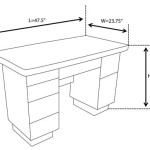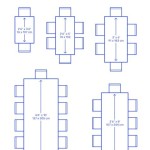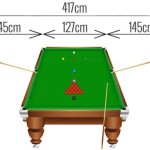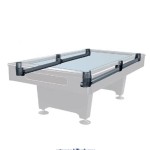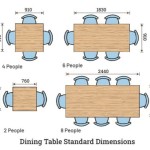Chair Height Considerations for Dining Tables
Selecting the appropriate chair height for a dining table is essential for ensuring comfort and proper posture during meals and other activities. Incorrect chair height can lead to discomfort, back pain, and an overall unpleasant dining experience. A methodical approach considering several factors is crucial to achieving optimal comfort and functionality.
The standard dining table height typically ranges from 28 to 30 inches. This measurement is from the floor to the top surface of the table. This standardization provides a baseline for chair height selection, but individual needs and preferences should also be taken into account. Factors such as body size, chair design, and intended use of the table should influence the final decision.
Understanding the Importance of Seat Height
Seat height is defined as the distance from the floor to the top of the chair seat. This measurement directly impacts the user's legroom and posture. An ideal seat height allows the user's feet to rest comfortably flat on the floor, with knees bent at a 90-degree angle. This posture promotes proper spinal alignment and reduces strain on the lower back. Conversely, a chair that is too high will cause the user's feet to dangle, putting pressure on the back of the thighs and potentially leading to numbness or discomfort. A chair that is too low will force the user to slouch, compressing the spine and potentially causing back pain over time.
The generally recommended clearance between the seat of the chair and the underside of the table is between 10 and 12 inches. This space allows ample legroom for most individuals and prevents the user's thighs from bumping against the table apron. However, this clearance can be adjusted based on the specific dimensions of the table and chair, as well as the user's individual preferences. For example, individuals with longer legs may require slightly more clearance, while those with shorter legs may prefer a slightly smaller gap.
Measuring existing furniture can provide a useful reference point. If a current dining set is comfortable, measuring the table height and chair seat height will give valuable data. This information can then be used as a guide when selecting new chairs or a new table. If adjustments are needed, considering height-adjustable options might be a viable solution.
Factors Influencing Chair Height Selection
Several factors beyond standard measurements influence the ideal chair height for a dining table. These include the table's design, the intended use of the dining area, and the physical characteristics of the individuals who will be using the furniture. A careful assessment of these factors will contribute to a more personalized and comfortable dining experience.
The design of the table itself plays a key role. Tables with thicker tops or elaborate aprons (the decorative trim below the tabletop) may reduce the available legroom. In such cases, a chair with a slightly lower seat height may be necessary to maintain the recommended 10-12 inch clearance. Conversely, tables with thinner tops and minimal aprons offer more legroom, allowing for chairs with slightly higher seats.
The intended use of the dining area should also be considered. If the dining table is primarily used for formal meals, a more upright and formal seating posture may be desired. In this case, a chair with a slightly higher seat height may be appropriate. However, if the dining area is used for more casual activities, such as homework, games, or informal gatherings, a more relaxed and comfortable seating posture may be preferred. In this case, a chair with a slightly lower seat height may be more suitable.
The physical characteristics of the individuals who will be using the furniture are perhaps the most important factor to consider. Individuals with longer legs will naturally require more legroom and may benefit from a chair with a higher seat height. Conversely, individuals with shorter legs will require less legroom and may prefer a chair with a lower seat height. It is also important to consider any physical limitations or disabilities that may affect seating comfort. For example, individuals with back pain may benefit from a chair with good lumbar support and a slightly higher seat height to reduce strain on the lower back.
Practical Considerations for Chair and Table Combinations
When selecting chairs for an existing dining table, it's essential to take accurate measurements. Measure from the floor to the underside of the table, taking into account any apron or structural elements that may reduce legroom. Bring these measurements when shopping for chairs, and if possible, test the chairs with the table before making a final purchase. Many furniture stores allow customers to try out chairs with different table heights to ensure a comfortable fit.
If purchasing a new dining table and chairs as a set, the manufacturer will ideally have designed the pieces to be compatible. However, it is still prudent to verify the measurements and try out the set if possible. If mixing and matching tables and chairs from different manufacturers, it is crucial to pay close attention to the seat height and table height specifications. It is also important to consider the style of the chairs and table to ensure that they complement each other aesthetically.
Adjustable-height chairs and tables offer flexibility and can accommodate a wider range of users. These options are particularly useful in households with individuals of varying heights or in spaces where the dining area is used for multiple purposes. Adjustable chairs typically feature a mechanism that allows the seat height to be raised or lowered, while adjustable tables may have legs that can be extended or shortened.
Another practical consideration is the material of the chair seat. Harder seats may require cushions for added comfort, which can slightly increase the seat height. Soft, upholstered seats may compress slightly when sat upon, effectively reducing the seat height. These factors should be taken into account when determining the ideal chair height for a dining table. The thickness and firmness of any cushions should be considered when calculating the overall seat height. Testing the chair with and without cushions will help determine the best option.
The style of the chair also contributes to the overall comfort. Chairs with arms require additional clearance under the table. The armrests should ideally be able to slide under the table apron to allow the chair to be pushed fully under the table when not in use. The height of the armrests should be measured to ensure they do not interfere with the table apron. Chairs without arms offer more flexibility in terms of positioning and may be a better option for smaller spaces.
Finally, the overall aesthetic of the dining area should be considered. While comfort and functionality are paramount, the chairs should also complement the style of the table and the surrounding decor. Consider the materials, colors, and shapes of the chairs and table to create a cohesive and visually appealing dining space. The chairs should be proportional to the table and the room.

What Is The Ideal Dining Table And Chair Height

How To Pick The Right Dining Chair Height Inside

What Is The Ideal Dining Table And Chair Height

Dining Table Height Chair

Right Fit For Dinner A Table And Chair Sizing Guide Timber To

What Are Standard Table Heights

Dining Pub Chair Seat Height Comparison Find The Perfect Fit Amish Furniture Factory

What Is The Ideal Dining Table And Chair Height

Seat Height Table

What Is The Ideal Dining Table And Chair Height

